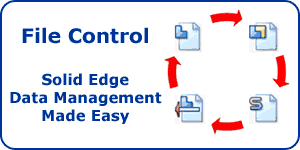Editing Imported Models The Easy Way
Warning: Use of undefined constant home_feature_photo - assumed 'home_feature_photo' (this will throw an Error in a future version of PHP) in /home/synchron/public_html/blog/wp-content/themes/WP-MagTheme10-Prem/single.php on line 70
We have seen quite a few examples of how we can use the tools in Solid Edge with Synchronous Technology in order to generate and manipulate designs which have been constructed natively in Solid Edge. So, the question is – How can we deal with imported models that were originally constructed in another CAD product? Well, the reality is that we can modify imported data just as easily as if we had generated it ourselves. All the tools and capabilities you have seen already such as the Steering Wheel, Live Rules, Parametric Dimensions – they can all be applied and used on an imported model too.
Before we look at what is possible using these new methods, I would like to illustrate what we would be able to achieve if we used the traditional ‘Direct Editing’ techniques that have been available in Solid Edge for a few years now. Direct Editing gave us the ability to move, rotate and offset faces, delete faces and regions, resize holes and more. Solid Edge was not the only mainstream application to provide these tools but as ever I believe Solid Edge’s capabilities were ahead of its competition.
Direct Editing could be applied to both imported data and native data. In fact it has been used many times to make minor modifications to a native complex model. Since the edits are placed as features at the end of the history, they do not upset other features further up the design tree. The problem is that direct edits are still history based and require a rebuild of the model when changes are made. Also when deciding which areas of the model to modify there is nothing automatically controlling the design intent.
Take a look at the video below to see the traditional direct editing capabilities in action on a simple component. Once you have watched this, take a look at the next video showing some similar modifications using Synchronous methods
View a higher quality version of this video
Now take a look at the same modifications being made within a Synchronous environment. Notice how much quicker and easier it is to select the elements to modify as well as the move direction and all the time maintain design intent. Also the huge bonus is that we can drive an imported part with our own PMI dimensions. Try doing that in a traditional parametric CAD system!
View a higher quality version of this video
Keep an eye open for more information on Solid Edge with Synchronous Technology or subscribe to our feed for automatic notification.




